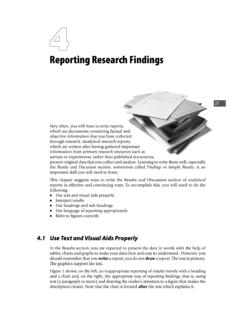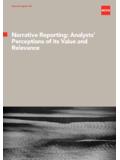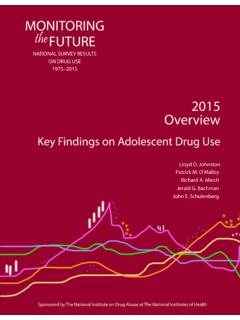Transcription of Standards for Reporting Qualitative Research: A Synthesis ...
1 Copyright by the Association of American Medical Colleges. Unauthorized reproduction of this article is Medicine, Vol. 89, No. 9 / September 20141 research ReportQualitative research contributes to the literature in many disciplines by describ-ing, interpreting, and generating theories about social interactions and individual experiences as they occur in natural, rather than experimental, 3 Some recent examples include studies of professional dilemmas,4 medical students early experiences of workplace learning,5 patients experiences of disease and interventions,6 8 and patients perspec-tives about incident The purpose of Qualitative research is to un-derstand the perspectives/experiences of individuals or groups and the contexts in which these perspectives or experiences are ,2,10 Qualitative research is increasingly common and valued in the medical and medical education ,10 13 However, the quality of such research can be difficult to evaluate because of incomplete Reporting of key ,15 Quality is multifaceted and includes consideration of the importance of the research question.
2 The rigor of the research methods, the appropriateness and salience of the inferences, and the clarity and completeness of ,17 Although there is much debate about Standards for methodological rigor in Qualitative research ,13,14,18 20 there is widespread agreement about the need for clear and complete ,21,22 Optimal Reporting would enable editors, reviewers, other researchers, and practitioners to critically appraise Qualitative studies and apply and synthesize the results. One important step in improving the quality of Reporting is to formulate and define clear Reporting have proposed guidelines for the quality of Qualitative research , including those in the fields of medical education,23 25 clinical and health services research ,26 28 and general education ,30 Yet in nearly all cases, the authors do not describe how the guidelines were created, and often fail to distinguish Reporting quality from the other facets of quality ( , the research question or methods). Several authors suggest Standards for Reporting Qualitative research ,15,20,29 33 but their articles focus on a subset of Qualitative data collection methods ( , interviews), fail to explain how the authors developed the Reporting criteria, narrowly construe Qualitative research ( , thematic analysis) in ways that may exclude other approaches, and/or lack specific examples to help others see how the Standards might be achieved.
3 Thus, there remains a compelling need for defensible and broadly applicable Standards for Reporting Qualitative designed and carried out the present study to formulate and define Standards for Reporting Qualitative research through a rigorous Synthesis of published articles and expert formulated Standards for Reporting Qualitative research by using a rigor-ous and systematic approach in which we reviewed previously proposed Acad Med. 2014;89:00 published onlinedoi: for Reporting exist for many types of quantitative research , but currently none exist for the broad spectrum of Qualitative research . The purpose of the present study was to formulate and define Standards for Reporting Qualitative research while preserving the requisite flexibility to accommodate various paradigms, approaches, and authors identified guidelines, report-ing Standards , and critical appraisal criteria for Qualitative research by search-ing PubMed, Web of Science, and Google through July 2013; reviewing the reference lists of retrieved sources; and contacting experts.
4 Specifically, two authors reviewed a sample of sources to generate an initial set of items that were potentially important in Reporting Qualitative research . Through an iterative process of reviewing sources, modifying the set of items, and coding all sources for items, the authors prepared a near-final list of items and descriptions and sent this list to five external reviewers for feedback. The final items and descrip-tions included in the Reporting Standards reflect this Standards for Reporting Qualita-tive research (SRQR) consists of 21 items. The authors define and explain key elements of each item and provide examples from recently published articles to illustrate ways in which the Standards can be SRQR aims to improve the transpar-ency of all aspects of Qualitative research by providing clear Standards for report-ing Qualitative research . These Standards will assist authors during manuscript preparation, editors and reviewers in evaluating a manuscript for potential publication, and readers when critically appraising, applying, and synthesizing study see the end of this article for information about the should be addressed to Dr.
5 O Brien, Office of research and Development in Medical Education, UCSF School of Medicine, Box 3202, 1855 Folsom St., Suite 200, San Francisco, CA 94143-3202; e-mail: for Reporting Qualitative research : A Synthesis of RecommendationsBridget C. O Brien, PhD, Ilene B. Harris, PhD, Thomas J. Beckman, MD, Darcy A. Reed, MD, MPH, and David A. Cook, MD, MHPES upplemental digital content for this article is available at by the Association of American Medical Colleges. Unauthorized reproduction of this article is ReportAcademic Medicine, Vol. 89, No. 9 / September 20142 recommendations by experts in quali-tative methods. Our research team consisted of two PhD researchers and one physician with formal training and ex-perience in Qualitative methods, and two physicians with experience, but no formal training, in Qualitative first identified previously proposed recommendations by searching PubMed, Web of Science, and Google using com-binations of terms such as Qualitative methods, Qualitative research , qualita-tive guidelines, Qualitative Standards , and critical appraisal and by reviewing the reference lists of retrieved sources, reviewing the Equator Network,22 and contacting experts.
6 We conducted our first search in January 2007 and our last search in July 2013. Most recommenda-tions were published in peer-reviewed journals, but some were available only on the Internet, and one was an interim draft from a national organization. We report the full set of the 40 sources reviewed in Supplemental Digital Appendix 1, found at of us ( , ) reviewed an initial sample of sources to generate a comprehensive list of items that were potentially important in Reporting Qualitative research (Draft A). All of us then worked in pairs to review all sources and code the presence or absence of each item in a given source. From Draft A, we then distilled a shorter list (Draft B) by identifying core concepts and combining related items, taking into account the number of times each item appeared in these sources. We then compared the items in Draft B with material in the original sources to check for missing concepts, modify accordingly, and add explanatory definitions to create a prefinal list of items (Draft C).
7 We circulated Draft C to five experienced Qualitative researchers (see the acknowl-edgments) for review. We asked them to note any omitted or redundant items and to suggest improvements to the wording to enhance clarity and relevance across a broad spectrum of Qualitative inquiry. In response to their reviews, we consolidated some items and made minor revisions to the wording of labels and defini-tions to create the final set of Reporting Standards the Standards for Reporting Qualitative research (SRQR) summarized in Table explicate how the final set of stan-dards reflect the material in the origi-nal sources, two of us ( , ) selected by consensus the 25 most com-plete sources of recommendations and identified which Standards reflected the concepts found in each original source (see Table 2).ResultsThe SRQR is a list of 21 items that we consider essential for complete, transparent Reporting of Qualitative research (see Table 1). As explained above, we developed these items through a rigorous Synthesis of prior recommendations and concepts from published sources (see Table 2; see also Supplemental Digital Appendix 1, found at ) and expert review.
8 These 21 items provide a framework and recommendations for Reporting Qualitative studies. Given the wide range of Qualitative approaches and methodologies, we attempted to select items with broad SRQR includes the article s title and abstract (items 1 and 2); problem formulation and research question (items 3 and 4); research design and methods of data collection and analysis (items 5 through 15); results, interpretation, discussion, and integration (items 16 through 19); and other information (items 20 and 21). Supplemental Digital Appendix 2, found at , contains a detailed explanation of each item, along with examples from recently published Qualitative studies. Below, we briefly describe the Standards , with a particular focus on those unique to Qualitative , abstracts, and introductory material. Reporting Standards for titles, abstracts, and introductory material (problem formulation, research question) in Qualitative research are very similar to those for quantitative research , except that the results reported in the abstract are narrative rather than numerical, and authors rarely present a specific ,30 research design and methods.
9 Reporting on research design and methods of data collection and analysis highlights several distinctive features of Qualitative research . Many of the criteria we reviewed focus not only on identifying and describing all aspects of the methods ( , approach, researcher characteristics and role, sampling strategy, context, data collection and analysis) but also on justifying each ,14 This ensures that authors make their assumptions and decisions transparent to readers. This standard is less commonly expected in quantitative research , perhaps because most quantitative researchers share positivist assumptions and generally agree about Standards for rigor of various study designs and sampling Just as quantitative Reporting Standards encourage authors to describe how they implemented methods such as randomization and measurement validity, several Qualitative Reporting criteria recommend that authors describe how they implemented a presumably familiar technique in their study rather than simply mentioning the ,14,32 For example, authors often state that data collection occurred until saturation, with no mention of how they defined and recognized saturation.
10 Similarly, authors often mention an iterative process, with minimal description of the nature of the iterations. The SRQR emphasizes the importance of explaining and elaborating on these important processes. Nearly all of the original sources recommended describing the characteristics and role of the researcher ( , reflexivity). Members of the research team often form relationships with participants, and analytic processes are highly interpretive in most Qualitative research . Therefore, reviewers and readers must understand how these relationships and the researchers perspectives and assumptions influenced data collection and ,23,26,34 Results. Reporting of Qualitative research results should identify the main analytic findings. Often, these findings involve in-terpretation and contextualization, which represent a departure from the tradition in quantitative studies of objectively Reporting results. The presentation of results often varies with the specific quali-tative approach and methodology; thus, rigid rules for Reporting Qualitative find-ings are inappropriate.








